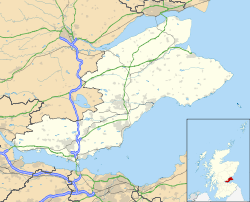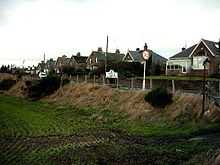Wormit
| Wormit | |
 Wormit, by the old railway station |
|
 Wormit |
|
| OS grid reference | NO3624 |
|---|---|
| Council area | Fife |
| Country | Scotland |
| Sovereign state | United Kingdom |
| Post town | Dundee |
| Postcode district | DD6 |
| Dialling code | 01382 |
| Police | Scottish |
| Fire | Scottish |
| Ambulance | Scottish |
| EU Parliament | Scotland |
| UK Parliament | North East Fife |
| Scottish Parliament | North East Fife |
Coordinates: 56°25′25″N 2°58′52″W / 56.42366°N 2.98107°W
Wormit (from Scots: Wirmit,[1] meaning "wormwood")[2] is a small town on the banks of the Firth of Tay in north-east Fife, Scotland. It is most famous for its location at the southern end of the Tay Rail Bridge, which has led to it becoming a commuter suburb of Dundee. Together with Woodhaven and Newport-on-Tay, Wormit is a part of The Burgh of Newport-on-Tay.

Wormit Station
Wormit Railway Station opened 1 May 1889[3] and closed on the 5th of May 1969,[4] was operated on a closed branch line, The Newport Railway, which left the main line (Edinburgh/Dundee) railway immediately at the south end of the Bridge to serve Wormit/Newport. After closure, Wormit Station was later dismantled and rebuilt at the heritage Bo'ness & Kinneil Railway to the west of Edinburgh.
In 1955, there was a serious train crash in Wormit Station in which three people were killed and forty-one were injured.[5]
Self-Powered
Wormit claims to be the first Scottish village to have installed electricity.[6][7] A windmill located on Wormit Hill generated the power, with a steam engine supplementing this when the wind was low. This was later replaced by a coal-gas engine until the 1930s, when Wormit was connected to the national grid. Alexander Stewart, who built many of Wormit's early houses, owned the windmill and steam engine[8] and offered electrical lighting to homeowners as well as basic street lighting. Consumers paid 10 shillings a quarter and could use as much electricity as they liked. The first houses to have electricity had sun rays painted on the front as a symbol that they were the first, and this is mostly noticeable along the highest row of terraced housing in the village (Hill Crescent).
It can also lay claim to being part of the start and continuance of many great British Comics, such as Action, 2000AD, The Beano, The Dandy and Commando and an inspiration and encouragement to many other great works.
Norwegian Connection
During the Second World War, King Haakon VII of Norway stayed in Wormit, in a house along Riverside Road. During this time his soldiers painted a sea motif for the king on the walls of the bathroom, and the motif is still present in the house. Norwegian Catalina flying boats were stationed at Woodhaven, and a Norwegian flag is still flown in the harbour, from where occasional pleasure sailings operate to Perth and back.
Water Reservoir
Wormit water reservoir was built in 1923 in anticipation of the population of the town growing, but war intervened and the reservoir was eventually decommissioned due to costs.[9] Trevor Cox, a professor of acoustic engineering at the University of Salford, identified the reservoir as one of the "strangest sounding places in the UK". It is essentially a large concrete box 60m long, 30m wide and 5m high. In a normal room, sounds die away quickly due to sound waves reflecting in to the walls, losing energy. In Wormit water reservoir, the size of the room means the time between reflections is much greater, coupled with sound waves losing less energy when reflecting off concrete, meaning sounds last for much longer. This was demonstrated by an experiment in which a balloon was popped inside the reservoir.[10]
Amenities & Services
Though small, Wormit has several amenities which serve a wider area. It has its own primary school, Church of Scotland, blacksmith, garage, post office, hair dresser and local shop. There are several sports clubs within Wormit namely Wormit Tennis Club, Wormit Bowling Club (instituted 1901) and Wormit Boating Club founded in 1911. The local police station, which covers both Wormit and Newport, is also situated just inside Wormit. The local secondary school is Madras College however parents may choose to send their children to any other secondary school in Fife, the most common choice of this option being Bell Baxter High School. Alternatively they may send them to either the High School of Dundee or St Leonards School, the two nearby private schools in Dundee and St Andrews respectively.
Many tranquil country walks can be taken in the area along the coastline to Balmerino Abbey.
References
- ↑ "The Online Scots Dictionary".
- ↑ MacKay, George (2003). Scottish Place Names. New Lanark: Geddes and Grosset. p. 96.
- ↑ http://canmore.rcahms.gov.uk/en/site/100953/details/wormit+naughton+road+station/
- ↑ Holland, Julian (2013). Dr Beeching's Axe 50 Tears on: Memories of Britain's Lost Railways. David & Charles. ISBN 9781446302675.
- ↑ "Report on the Derailment which occurred on 28th May 1955 at Wormit in the Scottish Region British Railways". Retrieved 9 June 2013.
- ↑ "Wormit - VisitScotland". Retrieved 9 June 2013.
- ↑ "Overview of Wormit". Retrieved 9 June 2013.
- ↑ "Riverside Road, Wormit - Photopolis". Retrieved 9 June 2013.
- ↑ http://www.bbc.co.uk/news/magazine-20773690
- ↑ http://www.bbc.co.uk/news/magazine-20784007